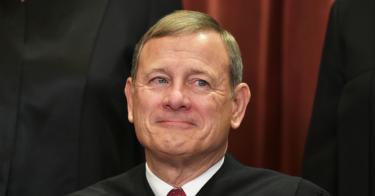America's longstanding debate about the politicization of the judiciary is by now so familiar that we have lost sight of its enigmatic character. Practically everybody, left and right, agrees that courts should somehow be above politics. At the same time, however, practically everybody can point to numerous instances of what they sincerely regard as egregious examples of politicized judging — important cases that courts have determined according not to law but to the political preferences of the judges. It is strange to find a phenomenon that is apparently prevalent despite being almost universally condemned.
This enigmatic problem is illustrated by the public career of America’s most famous — and perhaps most enigmatic — judge: John Roberts. Roberts is famously associated with the claim that judges should not be political. During his confirmation process he insisted that judges should be only “umpires” and not players in the game of politics. At the same time, Roberts has not been able to shake the accusation — made by his enemies, and sometimes even by his friends — that he himself is a political judge, that he has let considerations other than the Constitution and the laws determine the outcome of important cases.
This difficulty — Roberts’s desire to avoid politics while perhaps being unable to do so — is a key theme of Joan Biskupic’s new biography. Biskupic covers Roberts’s whole life. The book includes revealing accounts of his youth and education, his work in the Reagan administration, his distinguished career as an appellate litigator, his brief service on the United States Court of Appeals for the District of Columbia Circuit, and his early elevation to chief justice of the Supreme Court. Biskupic’s principal concern, however, is how Roberts’s work as a judge is influenced by his politics — both by his own political conservatism and by his concern for the Court’s public reputation.
As the author of previous biographies of Justices Scalia, O’Connor, and Sotomayor, Biskupic is an experienced observer of the Supreme Court. As a result, The Chief is unfailingly informative and engaging. Nevertheless, the book’s account of the nexus between law and politics is marred by two defects. These defects might be considered fortuitous, however, insofar as they help to illustrate the difficulties involved in grappling with the problem of politicized judging.
In the first place, Biskupic’s account is somewhat biased. This is not to say that the book is malicious. Biskupic seems to respect and like the chief justice. But she is part of the liberal legal establishment, and it shows. The book seems to be organized more around her own preoccupations than around those of its subject. Issues that involve race — such as voting-rights cases and challenges to affirmative action in higher education — receive extensive treatment, while other, no less interesting and important questions are scanted or ignored.
The constitutionality of capital punishment, for example, is both inherently interesting and reliably controversial. Biskupic treats it only cursorily. Even more strange is the lack of any discussion of Boumediene v. Bush (2008), in which the Court, over the objections of Roberts and three other conservative dissenters, for the first time declared that enemy combatants held outside the United States have a right to habeas corpus. This case was the capstone of a series of controversies in which the Court had engaged in a tug of war with the presidency and the Congress over the rights of enemy combatants detained in the American prison at Guantanamo Bay, Cuba. One would certainly think that it merits inclusion in any book that wants to give a complete and impartial account of Roberts’s time as chief justice.
It is therefore hard to suppress the suspicion that Biskupic has lavished attention on areas of the law where she thinks she can plausibly suggest that Roberts has allowed his legal thinking to be shaped by politics, but she has studiously avoided those areas where it would look like the liberal justices were guilty of the same thing. This is a commonplace fault of most arguments about what is often called “judicial activism.” Political judging is a real problem, but the criticisms of it often turn out to be “political” or partisan themselves. That is, they turn out to be not principled calls for courts to remain above politics but argumentative weapons to be wielded against judges who have disappointed our political hopes.
This brings us to the book’s second defect. To get a clear understanding of how political considerations influence the work of the courts, we would need judges to speak candidly and publicly about this question. This they are famously reluctant to do, however, and Biskupic has not succeeded in piercing their reticence. To judge from her footnotes and acknowledgments, she extensively interviewed a number of the justices, including Roberts himself. But none of them spoke with her on the record about the deliberative process in particular cases.
This drawback undermines what many readers will find to be one of the most interesting parts of the book: its behind-the-scenes account of how the Court reached its decision in the Obamacare case, NFIB v. Sebelius (2012). According to Biskupic, Roberts began by thinking that the law’s “individual mandate” was unconstitutional and that its Medicaid expansion was constitutional. During the course of the Court’s private deliberations, however, he began to think that the mandate could be upheld under Congress’s taxing power, but also started to think that the Medicaid expansion unconstitutionally coerced the states into participation. On Biskupic’s telling, Justices Breyer and Kagan joined in Roberts’s rejection of the Medicaid expansion in order to shore up his support for the individual mandate. If true, this amounted to something close to political horse trading. But it is difficult to know how much to credit the story when none of the participants would vouch for it on the record.
This piece originally appeared in National Review




